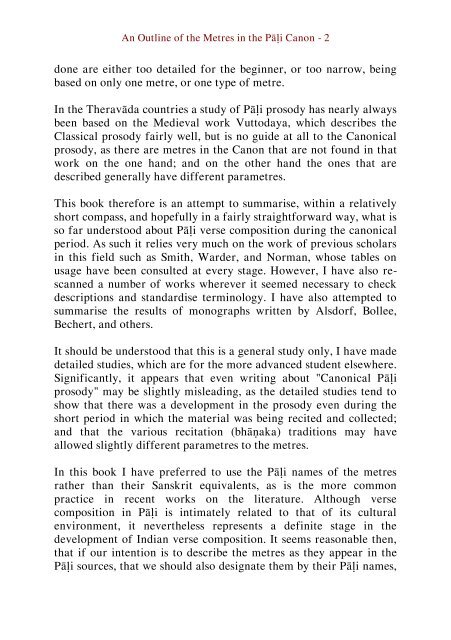An Outline of the Metres in the Pāḷi Canon
A concise but thorough explanation of the metres that are found in the Pāli canon, along with examples and glossary.
A concise but thorough explanation of the metres that are found in the Pāli canon, along with examples and glossary.
Create successful ePaper yourself
Turn your PDF publications into a flip-book with our unique Google optimized e-Paper software.
<strong>An</strong> <strong>Outl<strong>in</strong>e</strong> <strong>of</strong> <strong>the</strong> <strong>Metres</strong> <strong>in</strong> <strong>the</strong> <strong>Pāḷi</strong> <strong>Canon</strong> - 2<br />
done are ei<strong>the</strong>r too detailed for <strong>the</strong> beg<strong>in</strong>ner, or too narrow, be<strong>in</strong>g<br />
based on only one metre, or one type <strong>of</strong> metre.<br />
In <strong>the</strong> Theravāda countries a study <strong>of</strong> <strong>Pāḷi</strong> prosody has nearly always<br />
been based on <strong>the</strong> Medieval work Vuttodaya, which describes <strong>the</strong><br />
Classical prosody fairly well, but is no guide at all to <strong>the</strong> <strong>Canon</strong>ical<br />
prosody, as <strong>the</strong>re are metres <strong>in</strong> <strong>the</strong> <strong>Canon</strong> that are not found <strong>in</strong> that<br />
work on <strong>the</strong> one hand; and on <strong>the</strong> o<strong>the</strong>r hand <strong>the</strong> ones that are<br />
described generally have different parametres.<br />
This book <strong>the</strong>refore is an attempt to summarise, with<strong>in</strong> a relatively<br />
short compass, and hopefully <strong>in</strong> a fairly straightforward way, what is<br />
so far understood about <strong>Pāḷi</strong> verse composition dur<strong>in</strong>g <strong>the</strong> canonical<br />
period. As such it relies very much on <strong>the</strong> work <strong>of</strong> previous scholars<br />
<strong>in</strong> this field such as Smith, Warder, and Norman, whose tables on<br />
usage have been consulted at every stage. However, I have also rescanned<br />
a number <strong>of</strong> works wherever it seemed necessary to check<br />
descriptions and standardise term<strong>in</strong>ology. I have also attempted to<br />
summarise <strong>the</strong> results <strong>of</strong> monographs written by Alsdorf, Bollee,<br />
Bechert, and o<strong>the</strong>rs.<br />
It should be understood that this is a general study only, I have made<br />
detailed studies, which are for <strong>the</strong> more advanced student elsewhere.<br />
Significantly, it appears that even writ<strong>in</strong>g about "<strong>Canon</strong>ical <strong>Pāḷi</strong><br />
prosody" may be slightly mislead<strong>in</strong>g, as <strong>the</strong> detailed studies tend to<br />
show that <strong>the</strong>re was a development <strong>in</strong> <strong>the</strong> prosody even dur<strong>in</strong>g <strong>the</strong><br />
short period <strong>in</strong> which <strong>the</strong> material was be<strong>in</strong>g recited and collected;<br />
and that <strong>the</strong> various recitation (bhāṇaka) traditions may have<br />
allowed slightly different parametres to <strong>the</strong> metres.<br />
In this book I have preferred to use <strong>the</strong> <strong>Pāḷi</strong> names <strong>of</strong> <strong>the</strong> metres<br />
ra<strong>the</strong>r than <strong>the</strong>ir Sanskrit equivalents, as is <strong>the</strong> more common<br />
practice <strong>in</strong> recent works on <strong>the</strong> literature. Although verse<br />
composition <strong>in</strong> <strong>Pāḷi</strong> is <strong>in</strong>timately related to that <strong>of</strong> its cultural<br />
environment, it never<strong>the</strong>less represents a def<strong>in</strong>ite stage <strong>in</strong> <strong>the</strong><br />
development <strong>of</strong> Indian verse composition. It seems reasonable <strong>the</strong>n,<br />
that if our <strong>in</strong>tention is to describe <strong>the</strong> metres as <strong>the</strong>y appear <strong>in</strong> <strong>the</strong><br />
<strong>Pāḷi</strong> sources, that we should also designate <strong>the</strong>m by <strong>the</strong>ir <strong>Pāḷi</strong> names,

















